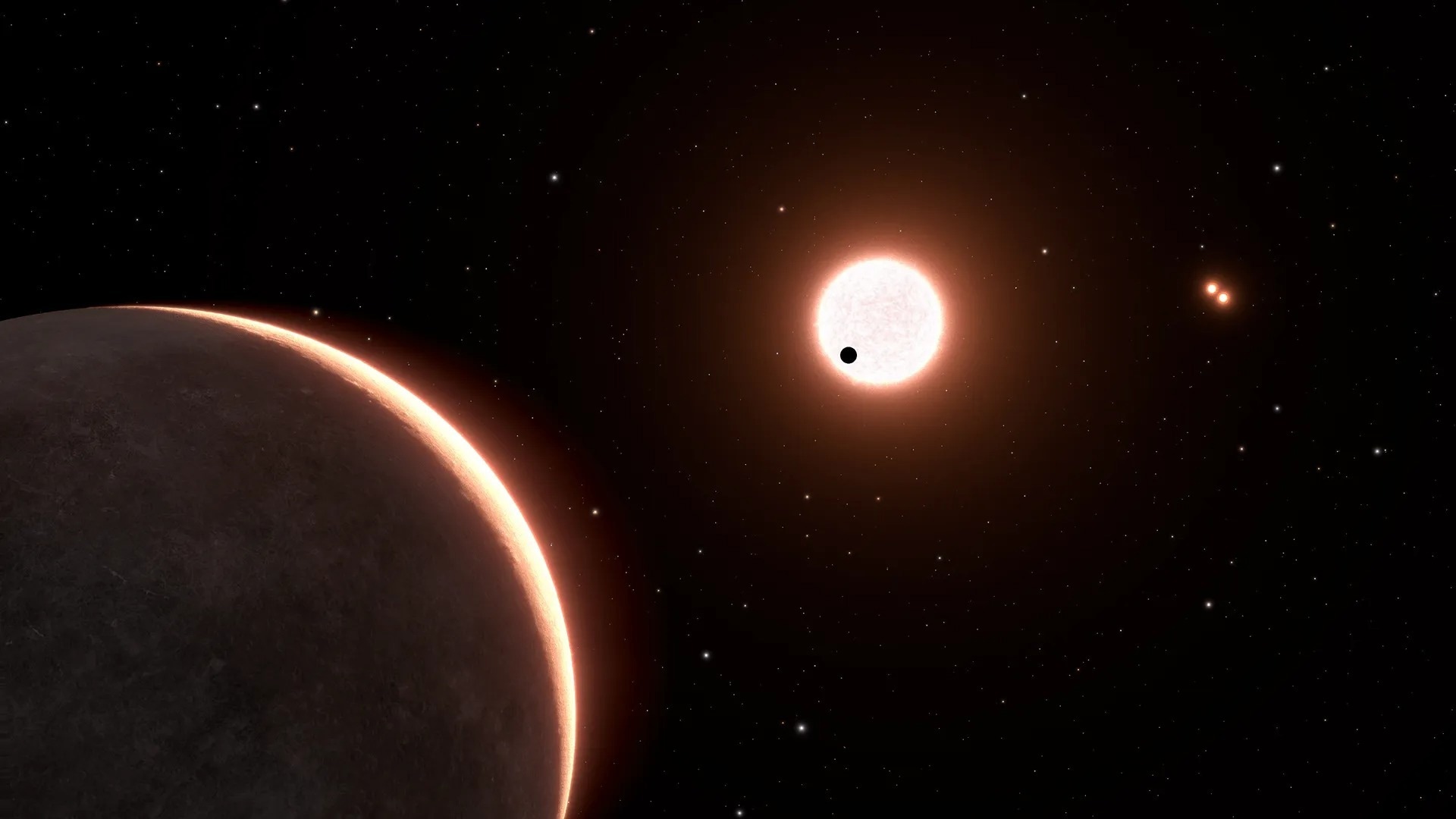The Hubble Space Telescope of NASA has measured the size of the nearest Earth-sized exoplanet that crosses the face of a neighboring star. This alignment, known as a transit, opens the door to further research into the rocky world’s atmosphere, if it has one.

This is an artist’s concept of the nearby exoplanet LTT 1445Ac, which is the size of Earth. The planet orbits a red dwarf star. The star is in a triple system, with two closely orbiting red dwarfs seen at upper right. The black dot in front of the bright light-red sphere at image center is planet LTT 1445Ac transiting the face of the star. The planet has a surface temperature of roughly 500 degrees Fahrenheit. In the foreground at lower left is another planet in the system, LTT 1445Ab. The view is from 22 light-years away, looking back toward our Sun, which is the bright dot at lower right. Some of the background stars are part of the constellation Boötes. Image Credit: NASA, ESA, Leah Hustak (STScI)
LTT 1445Ac, a small planet, was discovered in 2022 by NASA’s Transiting Exoplanet Survey Satellite (TESS). However, because TESS lacks the needed optical resolution, the geometry of the planet's orbital plane relative to its star, as seen from Earth, was unknown. This implies that the detection could have been a grazing transit, in which a planet merely passes through a small area of the parent star’s disk. This would result in an incorrect lower limit on the planet’s diameter.
There was a chance that this system has an unlucky geometry and if that is the case, we would not measure the right size. But with Hubble’s capabilities we nailed its diameter.
Emily Pass, Ph.D. Student, The Center for Astrophysics | Harvard & Smithsonian
According to Hubble measurements, the planet completes a normal transit over the star’s disk, resulting in a true size of only 1.07 times Earth’s diameter. This implies that the planet is a rocky world like Earth, with roughly the same surface gravity. However, with a surface temperature of approximately 500 degrees Fahrenheit, it is far too hot for life as everybody now knows it.
The planet revolves around the star LTT 1445A, which is part of a triple system of three red dwarf stars in the constellation Eridanus 22 light-years away. There are two more reported planets larger than LTT 1445Ac around the star. LTT 1445B and C, a close pair of two additional dwarf stars, are around 3 billion miles apart from LTT 1445A and were likewise resolved by Hubble. The alignment of the three stars, as well as the BC pair’s edge-on orbit, suggests that everything in the system, including the known planets, is co-planar.
Pass added, “Transiting planets are exciting since we can characterize their atmospheres with spectroscopy, not only with Hubble but also with the James Webb Space Telescope. Our measurement is important because it tells us that this is likely a very nearby terrestrial planet. We are looking forward to follow-on observations that will allow us to better understand the diversity of planets around other stars.”
The Astronomical Journal has accepted this study for publication.
NASA and ESA are working together internationally on the Hubble Space Telescope project. The telescope is operated by NASA’s Goddard Space Flight Center located in Greenbelt, Maryland. Hubble science operations are carried out by the Space Telescope Science Institute (STScI) located in Baltimore, Maryland. The Association of Universities for Research in Astronomy in Washington, D.C., manages STScI on behalf of NASA.
Journal Reference
Pass, E. K., et al. (2023) HST/WFC3 Light Curve Supports a Terrestrial Composition for the Closest Exoplanet to Transit an M Dwarf. The Astronomical Journal. doi:10.48550/arXiv.2307.02970.